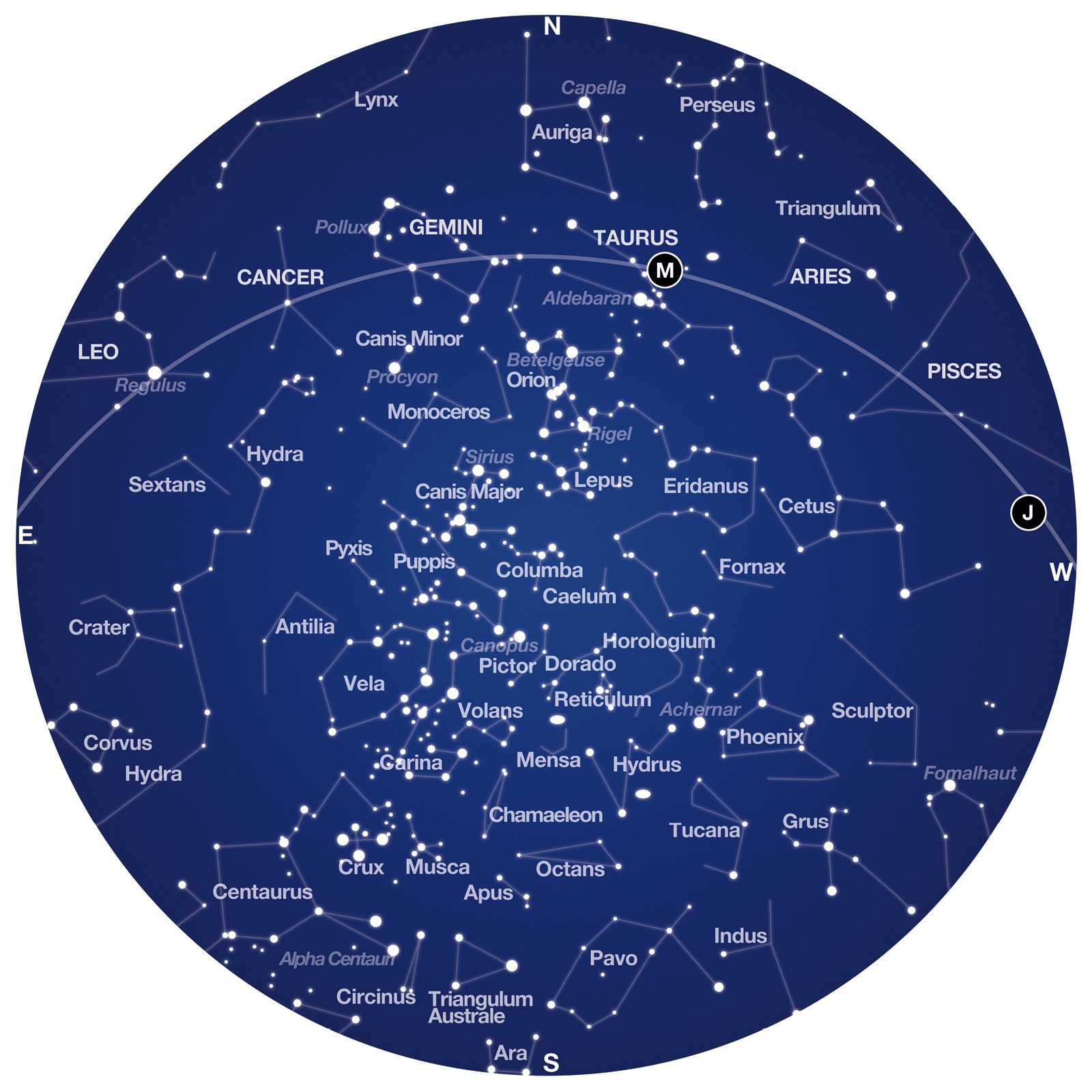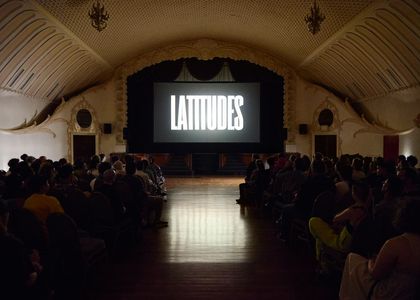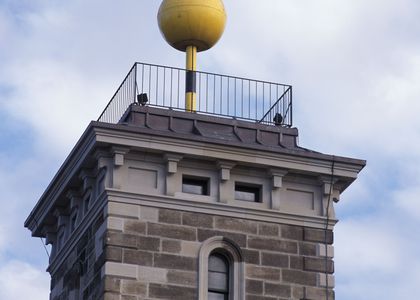
Monthly sky maps from the 2023 Australasian Sky Guide by Powerhouse Publishing and NewSouth.
What’s in the sky this January?
Constellations
Constellations represent groupings of stars that have been given a name. For millennia they have been used as a tool to share significant cultural stories. Today, they also help astronomers delineate portions of the sky and are a navigational tool for locating astronomical objects. This month these constellations dominate the sky:
- The summer trio of the Bull, the Hunter and his Great Dog dominates the sky this month – look to the north and around to the east each evening to see these constellations. Each is described below.
- Taurus – the Bull is due north, his head composed of an upside-down V-shaped star pattern. The yellow-orange star at the end of one arm of the V is Aldebaran, the Bull’s eye. Aldebaran is a nearby red-giant star and the V-shaped group of stars are part of a nearby cluster of young stars called the Hyades. But, just to emphasise that not everything in the sky is as it appears, Aldebaran is not part of the Hyades group, but a foreground star just 67 light-years away. Taurus represents the Bull into which Zeus transformed himself to abduct a young and beautiful Europa. He carried her off to Crete where he seduced her and gifted her a dog, Canis Major.
- Orion – the Hunter lies to the right (east) of Taurus, the three stars of his belt are most easily spotted. Like all northern hemisphere constellations he is upside down from our southern perspective. Below his belt is bright reddish Betelgeuse, his shoulder, and above is bright white Rigel, Orion’s knee. The mythology of Orion is confused. No Greek myth links him to Taurus but in earlier Sumerian legends he is the equivalent of Heracles – who did battle the Bull of Crete. Homer describes him as a great hunter holding an unbreakable club of bronze and followed by dogs as he chases the Hare (constellation Lepus). Orion fell in love with the Pleiades, who he still chases westwards across the sky. He was killed when a giant scorpion (Scorpius) stung him, perhaps in the shoulder. Later in the night you will see Orion falter and set timidly in the west to avoid the Scorpion rising in the east.
- Canis Major – the Great hunting Dog of Orion (and gift of Zeus) lies (on his back!) further to the east (right) where Sirius, the brightest star in the night sky, marks his shoulder.
- Eridanus – the River in the sky meanders from Rigel, up high overhead and on to the southern star Achernar. Can you follow this river of stars across the sky using our star map?
Planets
This month Venus, Mars, Jupiter and Saturn are our evening planets. Mercury spends a few days in the evening sky before moving to the morning sky. If you have trouble identifying planets from stars the Moon comes to your aid.
- Mercury – the speedy Messenger of the gods is true to form this month, announcing his presence briefly (if faintly) at dusk before dashing across the sky to appear at dawn. For the first few days of the month you will find him in the evening twilight, to the south-west, below bright Venus – binoculars will be necessary. From the middle of January look to the east before sunrise. On January 30 Mercury is at its greatest apparent distance from the Sun, or “greatest elongation west” (this happens three times this year), and well placed to observe.
- Venus – is the Evening Star, low in the west after sunset and very bright & white. She moves from Sagittarius through Capricornus and into Aquarius during the month as she slowly climbs further from the Sun. On the 22nd Venus is just to the left of much fainter Saturn and on the 23rd just above Saturn – on both nights at a separation of about a moon-width. On the 23rd a very thin crescent Moon joins the pair, above left of them. Binoculars will be helpful here to locate the Moon and you will need a clear western horizon. This is the naked-eye highlight of the month.
- Mars – is bright orange-red in the northern sky in Taurus during evenings this month. For the whole month it lies below the (much fainter) star Aldebaran and to the right of the sparkling cluster of stars we call the Pleiades.
- Jupiter – shining bright yellow, begins January in the north-western sky in Pisces and sinks towards the western horizon as the month goes on.
- Saturn – is low in the western sky, in Capricornus, and faint this month. As the nights of January pass Saturn sinks lower towards the western horizon, passing Venus on the 22nd and 23rd before disappearing into the western twilight by month’s end.
The Moon
- Full Moon is on Saturday 7th January at 10:08am
- Last Quarter is on Sunday 15th January at 1:10pm
- New Moon is on Sunday 22nd January at 7:53am
- First Quarter is on Sunday 29th January at 2:19am
Let the Moon be your guide to the planets…
On January 3rd a gibbous Moon is to the left of Mars in the evening sky.
On January 20th a thin crescent Moon is above & right of Mercury in the dawn sky.
On January 23rd a very thin crescent Moon is above and left of Venus and Saturn in the evening sky. Binoculars will be helpful to spot the Moon.
On January 26th a crescent Moon sits to the right & above Jupiter in the evening sky.
And finally on January 31st a gibbous Moon is to the right of Mars in the evening sky.
Deep Sky
Explore the universe through your binoculars or telescope and take in some of the gems of the January sky. These look at their best with no Moon in the sky:
- The Hyades – the V-shape of Taurus’ head is a cluster (or group) of stars about 150 light years distant. All were born from the same hydrogen gas cloud several million years ago. Surprisingly, Aldebaran, the eye of the Bull, is not part of the cluster but is a foreground star. Through binoculars you can spot fainter members of the cluster scattered around the Bull’s head.
- The Pleiades – another star cluster, this one named after seven sisters born to Atlas and Pleione. This small group to the left of the Hyades catches the eye and is known worldwide. How many stars can you count by eye in this group? Stories from cultures across the planet refer to these stars, often referring to seven siblings of whom one goes missing. The Pleiades were used as a seasonal calendar to announce harvest time (when they rose at dawn) and when they were visible at night it was safe to sail on the Mediterranean Sea.
- Orion nebula – a huge star-birth cloud of gas and dust this nebula is just visible to the naked eye. It lies in the sword of Orion which hangs upwards from his belt – from our southern point-of-view. Through binoculars, or better still through a telescope, you see swirls of hydrogen gas, dark obscuring dust and many new-born stars.
- The Large and Small Magellanic Clouds (LMC & SMC) – these cloud-like features in the southern sky are two small companion galaxies to the Milky Way. If you are away from city lights and if your eyes have had 10-15 minutes to adjust to the darkness look due south. High up are two hazy patches of ‘cloud’ the Large to the left (or above later in the night) and the Small to the right (below). The light from their stars that you see today left these galaxies 200,000 years ago.
Other Events in January 2023
On Thursday January 5th at 3:17am AEDT Earth reaches its closest point to the Sun for the year, called perihelion. Earth is a little over 147-million kilometres from the Sun and travelling at its fastest along its orbit.
The year ahead
It’s January so let’s have a look ahead at the main astronomical and space events and anniversaries for 2023.
In Astronomy…
The biggest astronomical event this year is the total solar eclipse of April 20. This one is visible from Australia, but only from the peninsula of North-West Cape in Western Australia is totality visible. Everywhere else on the Australian mainland you’ll see a partial solar eclipse – still worth observing if you use the correct equipment to protect your eyesight. If you miss it the consolation prize is a partial solar eclipse on October 29. This is not nearly as exciting, but is worth a look if you have the correct equipment and this time only if you live in the western half of the country.
There are a few nice planetary conjunctions, groupings and appulses, all occurring in the first half of the year. After the January 23 Venus-Saturn-Moon grouping mentioned above we’ll see Venus & the crescent Moon meet-up on February 22, Venus & Jupiter close on March 2 and a Venus-Mars-Moon get-together on June 22.
There are two Supermoons (or Full Moons at Perigee to be more technically descriptive) in August (the 2nd and 31st), and two more on July 3 and September 29 if you use a broader definition for ‘Supermoon’. Now, if you’re ahead of me you’ve noticed that August has two Full Moons – and you may know that the second one is termed a Blue Moon. So that makes the August 31 full moon a Blue Supermoon!
Finally, on December 15 the Geminids meteor shower is at its best, and this year there is no Moon around to brighten the sky. I’m hoping for a good showing from them this year.
In Space…
The very successful Artemis I mission late last year released several Lunar probes. Although these were mostly technology demonstrators we may soon hear some results from them. This year more Lunar spacecraft, including a lander (Nova-C) may be launched.
In September the OSIRIS-REx spacecraft flies by Earth and jettisons a capsule containing material from the asteroid Bennu. The sample was collected back in 2020 so there are some patient scientists eagerly awaiting that delivery. In 2020 the Japanese spacecraft Hyabusa2 delivered 5.4gm of material from asteroid Ryugu, OSIRIS-REx is expected to return over 100 times that.
In December the Juno spacecraft orbiting Jupiter is scheduled to begin two close passes of the volcanic moon Io. Look out for some spectacular images.
The JUICE (JUpiter ICy moons Explorer) mission of the European Space Agency (ESA) is scheduled to launch in 2023. It will make a detailed study of Jupiter and its three largest moons, Europa, Ganymede and Callisto.
ESA also has the Euclid space telescope scheduled for launch this year. It will investigate two of the three great mysteries of the universe, dark matter and dark energy.
Anniversaries…
This year is the centenary of the planetarium, 100 years since the completion of the Zeiss ‘Model 1’ planetarium projector & the first planetarium presentations – the forerunner to all the large projection planetariums of the 20th Century. Perhaps we will solve the third great mystery – why Sydney has never had a permanent large planetarium, like all the other great cities of the world?
And on February 13 we mark 10-years since a small asteroid streaked across the skies of Siberia and exploded above the city of Chelyabinsk, all recorded on dash-cams. Windows were shattered and people injured. It will happen again although steady progress is being made on identifying such rocks before they arrive.
Learn More
- Purchase the 2023 Australasian Sky Guide by Dr Nick Lomb, featuring an annual report of what’s in the sky and the latest astronomical findings. Produced by MAAS Media.
- View the Star Map January 2023, which shows the stars, constellations and planets visible in the night sky from anywhere in Australia
- Check out these resources for getting started


